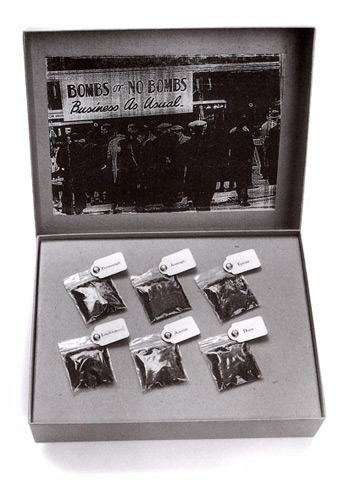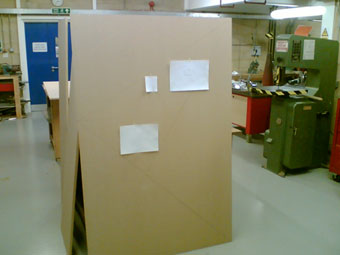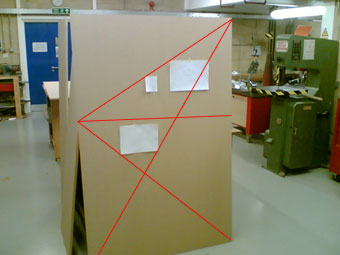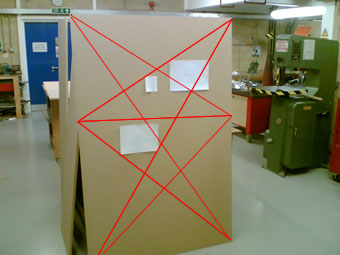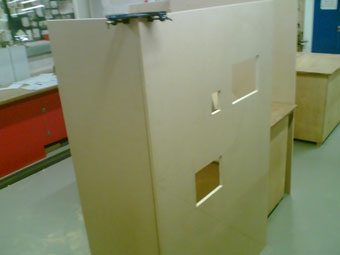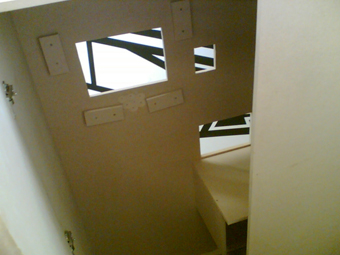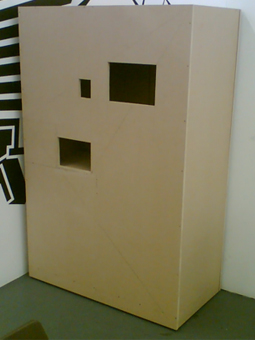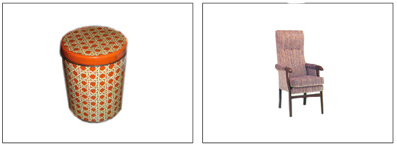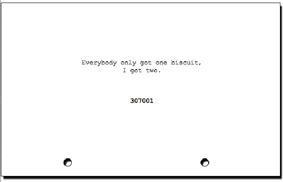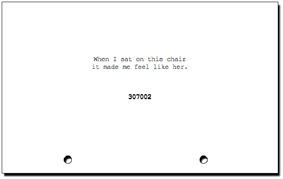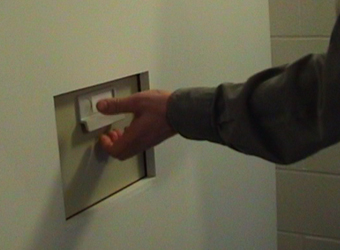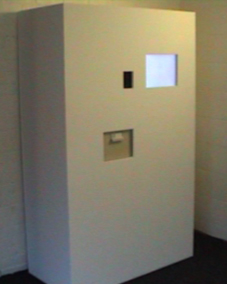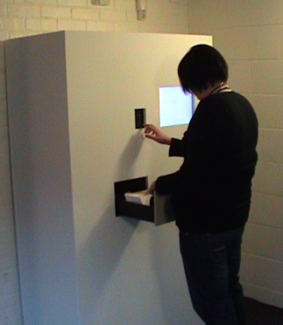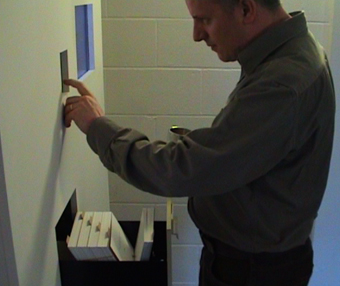|
Physical Index Final Project - Paul Glennon - Module 4
|
||||||||||||||||||||||||
Information retrieval is faster now than ever, especially with the advent of the computer and the Internet. Whole museum libraries can be accessed online from the other side of the world in an instant. This is a great advance as it allows us to research and send information automatically. But is there a loss? Is it still possible to find a book in a library by accident? We can browse online, but is this proper ‘window shopping’ or are we really just staring at ‘Windows 2000’? Index systems have changed dramatically due to the digital era that we are living in. This work will focus on the loss of paper-based indexing in favour of screen-based systems.
‘From the Freud Museum’ by Susan Hiller is currently in the Tate Modern in London, but it was previously created as an installation for the Freud Museum at 20 Maresfield Gardens, London (Sigmund Freud’s former home). Most of the work is not directly linked to Freud but more to the ‘I’ of Hiller’s daily life and her anthropological approach to her art work. The many boxes that are collected in this exhibition show a vast array of material from around the world. The brown display cases that hold the material have been very carefully made to house the objects, almost like a museum collection of bones or relics. To accompany the exhibition at the Tate, Hiller created a book as an extension of the art work called ‘After the Freud Museum’. In the afterword for this book Hiller mentions the collection of artefacts and objects in the existing Freud Museum as being complicated by ‘an overlay of settings (that) merge to representations whose meanings are always in flux’. She goes on to say that Freud’s collection could be seen as ‘an archive of the version of civilization’s heritage that he was claiming’. Hiller describes her work in the following way: ‘...my collection is more like an index to some of the sites of conflict and disruption that complicate any such notion of heritage’ (Hiller, 2000) Hiller is indexing her items as a response to the Freud collection. It would appear that she does so to obtain a reaction to indigenous items displayed together, thus evoking a response. There are many ways that Hiller could have displayed her collection, but the metaphor of a museum is important and the index element is further extended in her book.
‘1000mm’
was created by Stanley Brouwn in 1974, and is currently in the
Tate Modern, London. This piece of work explicitly uses indexing
in its very structure. 1000mm (a particular journey) is measured
out on index cards and stored in an elongated index drawer sat
on a purpose-built table. This piece of work demonstrates Brouwn’s
interest in measuring his own footsteps, both in actuality and
metaphorically (sketch below). Like many conceptual artists from that period, Brouwn was interested more in the actual process or act of creating work. Although the index cards are part of the physical make-up, they are not the central focus. Recently Brouwn has exhibited work in the Christine Burgin Gallery, New York. The recording of distance through measurement is still central, only the medium he uses is books. In the actual exhibition, these minimal books are stacked in simple white bookshelves and serve as a catalogue of events in the artist’s life. It is interesting to see, like Hiller, that the book has now become central to the artist’s work. Like a dictionary, it becomes a reference book.
It could be said that there is no direct index in Hanne Darboven’s work, however, she does supply curators with an index along with the work which, ‘provides information on the coding system to be used’ (Marzoni, 2005). The reason why Darboven needs to supply such information is because her work is constructed using numerical systems to represent calendar dates on graph paper. These dates, in some cases, have historical reference to important dates - such as ‘Quartett ‘88’’. In this piece of work Darboven celebrates the lives of four great women - Marie Curie, Rosa Luxumburg, Gertrude Stein and Virginia Woolf (below). For this later piece of work it is worth noting that Darboven uses image as well as notes on graph paper.
What
is interesting about Darboven’s work is her determination
to work out her own mathematical system which allows her to
create artworks about dates and time. In order to do this she
writes endless notes that rely on a successful information retrieval
system. ‘...with
enormous discipline and precision, she filled page after page
with calendar dates, on which she imposed a system by working
out the sum of the digits for days, months and years and translating
them into geometric forms, as well as summarizing them in indices.
In this way temporal extension is made accessible to the senses.
One other area of interest is Darboven’s recent ‘collectors’ work. Her studio in Hamburg-Harburg has been converted into a collector’s shop with a mismatch of mass media paraphernalia. This work is a departure from her mathematical work to a more physical representation of how history can be recorded through various cultures. It is worth noting here that if Darboven is actually turning her studio into a collector’s shop or museum, then she may have some form of indexing system.
There are some visually interesting remnants from the Art & Language movement in the Tate Modern, London. For example ‘Map to Not Indicate..., 1967’. This work along with others was the result of co-operation between Terry Atkinson and Michael Baldwin who went to Coventry Art School together (and a host of other people from England and America).
What is ironic about the work in the Tate is the fact that the group refused, in the 60s and 70s, to produce actual artworks but instead would create opportunities to discuss art. These opportunities consisted of panel discussions, lectures and publications. One worth noting was the ‘Art-Language Journal’.
Ultimately, the work was collected together and (ironically) ended up in various exhibitions. Indexing was very pertinent in an exhibition entitled ‘documenta V’, 1972. The work, ‘Index 01’, consisted of the following: ‘In
a large room, two filing cabinets were set up on each of four
blocks. A total of 48 drawers contained the articles and fragments
of articles hitherto published in “Art-Language”,
along with some as yet unpublished. The articles were sorted
according to two criteria: at first they were placed in alphabetical
order, and within this scheme, they were ordered by their degree
of completeness. The large wall surfaces of the exhibition room
were covered almost completely with sheets of paper on which
Art & Language presented a complex system of indexing some
350 quotes.’
‘The Index challenged convention on all fronts: the nature of the artist (it was collectively produced); the nature of the work (it consisted of objects and texts); and the nature of the spectator (the work was to be read). (Wood, 2002) Wood
goes on to qualify this by referring to a statement by German
born philosopher, Rudolf Carnap: ‘how one does one’s
singling out determines what one singles out’. (Wood,
2002). In the traditional use of an index, when an ‘abstract’
is taken from a text it allows for successful ‘information
retrieval’. The elements brought together in an artwork
will allow the current audience from a particular culture and
time to retrieve information and establish the meaning or intention
of the artist.
Although the Turner Prize this year has not been awarded yet, there is one work in particular where indexing is playing a part. Phil Collins has created an actually functioning office that is dedicated to researching and recording information about people in Britain who have been on a television chat show between 1990 and 2000. He is interested in finding out how they have been affected by being on the show and how the general public are more willing now than in the past to talk publicly about their personal lives.
The work is called ‘Shady Lane Productions’ and supports his first piece of work which is a video installation of people from Turkey being interviewed about their experiences on chat shows. As the work spans two countries it can almost be called anthropological, and the juxtaposition of the two together is quite interesting.
In this office, which is has all the standard equipment, there is a visible filing system. Collins states, in a Tate Web cast, that there will be three to four people working in the office daily from 10am to 6pm. From the Web cast it is evident that he is more interested in the collecting of experiences, but if one sees the work (without prior knowledge), one is watching a live office in action. The very life of this office is visually interesting even before finding out what is going on.
The
work produced for this project will play on the fact that, currently,
one form of paper-based indexing is being replaced by a digital
one (as in the Natural History Museum in London). In doing so
it is hoped that the work will highlight a relationship between
the two forms which will cause a reaction, perhaps even evoke
some kind of empathy for one or the other and spark a debate
about the ongoing depletion of matter-based material.
These main findings have helped to direct this project in a particular direction. The project will consist of a digital / analogue index that catalogues all the items of an unknown person. One possible individual could be Mrs. E. Douglas (the author’s Grandmother), recently deceased, from Belfast, Northern Ireland. These items will be digitally photographed and printed onto index cards that will then be stored in the traditional sense. As with all indexes, observers will be allowed to ‘browse’ through the index and view the life of a person through the objects that they have left behind.
There were three things required to move this project forward. The first was the development of some sort of structure to hold the Physical Index. Feedback from the presentation indicated that how the work was presented would be important. The second was the mechanistic side of how the analogue index related to the digital, and the third was the actual content and subject matter of the index.
Alongside the building of the box, the content and subject matter of the index was being developed. As stated in the Preliminary Plan, Mrs. E. Douglas’ objects left behind after her death were photographed (over 250 items) from biscuit tins to religious icons. Ninety-two (the age that Mrs. Douglas died) of the objects were cleared of any background in Photoshop and saved as 750 x 550 pixel JPEGs. When the PC is switched on, it is set to automatically open the Web browser and the index software is set to run. (To do this you drag the browser to the Start menu and hold it over until the option opens - then set it to open.) The browser is set on full window to close off any Web graphics.
Prior to the presentation of this work, Physical Index was tested on students and staff at Thames Valley University, Reading Campus. The work was installed in a corridor and videoed (DVD attached to this Research Report). Below are some highlights from the DVD:
Some quotes from the DVD: “I was wondering whether it was the artist’s mother or grandmother... made me think of when my grandmother was alive.” Impressions gleaned from this testing suggested that people wanted to spend time looking through the quotes. The process of hunting through, selecting and then finding an image, kept people’s interest. The tactile qualities of the drawer and the keypad appeared satisfying as they matched similar processes in everyday life (eg, cash machine, ticket booths, etc.). FURTHER DEVELOPMENT CLOSING NOTES
|




